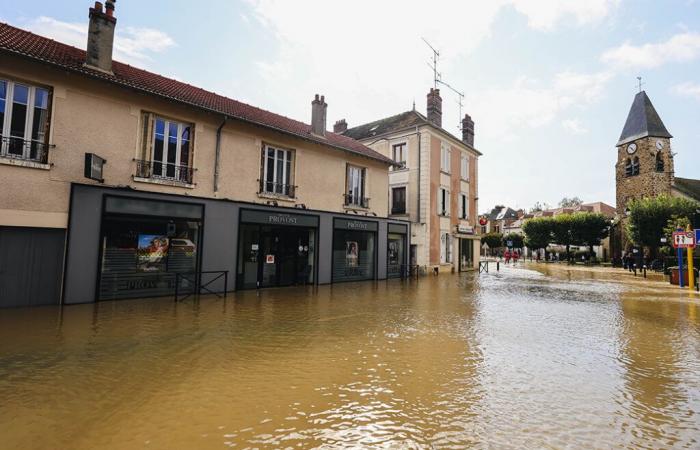Published on November 27, 2024par Frédéric Fortin, Epic communication for Localtis
North, Pas-de-Calais, Rhône, Loire, Ardèche, Alpes-Maritimes… The non-exhaustive list of areas hit by floods this year is growing like Le Gardon in the middle of the Cévennes rain. Episodes “are bound to repeat themselves”, Agnès Pannier-Runacher recently warned (see our article of October 18). Especially since the “particularly abundant” recharge of certain aquifers currently noted by the BRGM (see our article of November 18) is not without concern. The opportunity for the National Federation of Granting and Governed Communities (FNCCR), via a press conference held on November 27, to remind communities of their obligations in this area.
Floods: a risk that is both old and emerging
The phenomenon is certainly not new. Ministry figures in support, Régis Taisne, head of the Water Cycle department of the FNCCR, underlines that historically the flood risk is by far the most recurrent in France: 351 of the 524 “damaging natural events of all severities”, excluding waves of heat, recorded between 1900 and 2021. 18.5 million inhabitants are exposed to it, and in particular the 11.9 million people living in the 124 “territories at significant risk of flooding” (2,560 municipalities in total).
But the expert points out that this hazard is unfortunately set to spread geographically and increase, both in frequency and intensity. Taking up the conclusions of the Explore 2 study (see our article of June 28), he highlights “an increase of 20% on average in precipitation, especially in the North, and of 10% on average in the flow of rivers, in winter”. And the drought, which will be more pronounced in summer, will not help anything, because “dry soil is an aggravating factor in runoff and flooding because it does not infiltrate or very little”, he underlines.
Mayors on the front line
Faced with this challenge, mayors are “at the forefront”, indicates Pierre Kolditz, project manager for community management – water cycle at the FNCCR. No doubt more “on the front line”, as they are expected to be actors rather than spectators. The expert thus underlines that in their capacities as guarantors of public safety and health, managers of roads and urban rainwater or even key players in town planning (non-exhaustive list of responsibilities), it is up to them to do everything possible to “neutralize the risk, or in any case control it”. At the risk, failing that, of legal proceedings (see, following the Xynthia storm, the conviction of the mayor of La-Faute-sur-Mer, who died last week).
The challenge of the proper functioning of sanitation systems
While the revised directive on the treatment of urban waste water has just been definitively validated (see our article of November 6), the FNCCR draws particular attention to “the challenge of the proper functioning of sanitation systems”, a large part of rainwater being currently collected in public works and networks (the federation is organizing the 3 December one conference on the management of this rainwater and runoff). Régis Taisne aims in particular at the objective set by the text “to limit to 2% the volumes of water overflowed, without treatment, due to heavy rains”, while recalling that “a decree of July 21, 2015 [plusieurs fois modifié, la dernière fois en juillet dernier] sets a 5% target in France, but it is already not met everywhere”. It is a “tolerance, and not a right”, he insists, recalling that it is “about quality waters”. An issue recently highlighted by “two significant events: the Tolbiac basin for the swimming events [en eau libre] of the Olympic Games and the network overflows in the Arcachon basin last winter”, with the risk of repercussions “on oyster farming and food poisoning”.
A major challenge, the cost still unknown
The challenge is significant. Sandrine Potier, Spanc and rainwater technical advisor at the FNCCR, observes that “of the 400,000 km of existing networks, approximately 100,000 are unitary networks, which therefore receive both wastewater and rainwater”. Modifying them “is going to be very long and very expensive,” she warns. How much ? A certain cost, to paraphrase Fernand Raynaud. “A study was launched before the summer by the General Inspectorate of the Environment and Sustainable Development (IGEDD) and the General Inspectorate of Finance (IGF) to determine the cost of implementing the directive. results should be known before the end of the year, but I think it will be in the first quarter of next year,” says Régis Taisne. In passing, he is surprised that “we are waiting for the directive to be passed to launch the study”, proof that “the French State negotiated for two years in Brussels without having an idea of what it was going to cost” . Expensive, a priori. Sandrine Potier notes that “certain communities have taken part in the exercise”, and the calculations are not good. She takes the example of “Lyon, which estimates the cost of the work at around one billion euros”.
Swimming against the current
“There is not just one possible solution. It will be a mix of solutions,” she nevertheless wants to reassure. The expert ideally evokes “solutions based on nature”. But she concedes that it will undoubtedly also be necessary to go through “other solutions that are a little less green, such as more draining coatings, reservoir roads…” or even “embankments or embankments”. Returning to the fight against network overflows, Régis Taisne also believes that we must “not simply think in terms of volume of water, but in terms of polluting flows. Hence the interest in solutions such as storm basins, who are going [emmagasiner] the first flow water, those which collect the majority of the pollution”. Which will then be reinjected “into the sanitation networks, up to the treatment plant, once the latter are desaturated”.
Whatever the tool, the exercise seems to take the form of swimming against the current: “The more we improve things, the more climate change advances,” observes Régis Taisne. “It’s a permanent race between worsening rainy episodes and [la mise en œuvre de solutions] to try to contain them.






